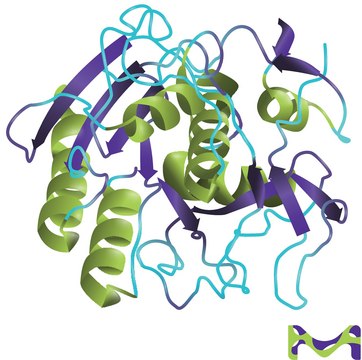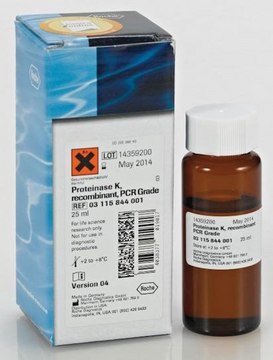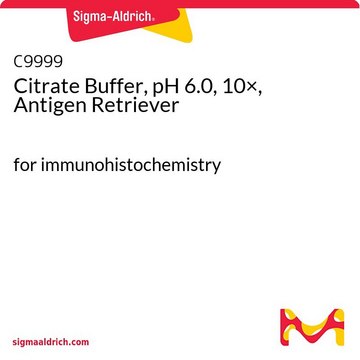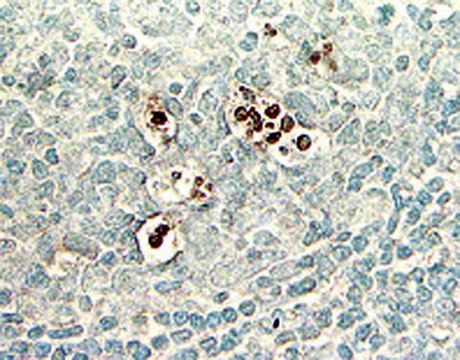21627-M
IHC Select Proteinase K
Synonym(s):
Antigen/ Epitope Retrieval Reagent
Sign Into View Organizational & Contract Pricing
All Photos(1)
About This Item
UNSPSC Code:
41116010
eCl@ss:
42029053
Recommended Products
packaging
pkg of 15 mL
Quality Level
manufacturer/tradename
Chemicon®
IHC Select
technique(s)
immunohistochemistry: suitable (paraffin)
Application
For use as a Pretreatment Reagent in Immunohistochemical staining procedures. Use Proteinase K to retrieve Epitopes in formalin-fixed, paraffin-embedded tissue sections mounted on glass microscope slides. This procedure is performed after deparaffinization and prior to IHC.
Warm to room temperature before use. Digestion time and dilution should be determined by user as concentration is dependent on the type of antibody, antigen, and fixation method used. Recommended starting dilution range: Neat to 1:30.
For best results use this reagent in conjunction with other IHC Select detection reagents. A complete list of reagents is available at www.chemicon.com.
Warm to room temperature before use. Digestion time and dilution should be determined by user as concentration is dependent on the type of antibody, antigen, and fixation method used. Recommended starting dilution range: Neat to 1:30.
For best results use this reagent in conjunction with other IHC Select detection reagents. A complete list of reagents is available at www.chemicon.com.
Physical form
Liquid Proteinase K containing 15mM sodium azide as a preservative. Discard if it becomes cloudy or contaminated.
Storage and Stability
When stored at 2-8°C, the Proteinase K is stable up to the expiration date printed on the label. Do not freeze or expose to elevated temperatures.
Legal Information
CHEMICON is a registered trademark of Merck KGaA, Darmstadt, Germany
Disclaimer
Unless otherwise stated in our catalog or other company documentation accompanying the product(s), our products are intended for research use only and are not to be used for any other purpose, which includes but is not limited to, unauthorized commercial uses, in vitro diagnostic uses, ex vivo or in vivo therapeutic uses or any type of consumption or application to humans or animals.
Storage Class Code
12 - Non Combustible Liquids
WGK
nwg
Flash Point(F)
Not applicable
Flash Point(C)
Not applicable
Certificates of Analysis (COA)
Search for Certificates of Analysis (COA) by entering the products Lot/Batch Number. Lot and Batch Numbers can be found on a product’s label following the words ‘Lot’ or ‘Batch’.
Already Own This Product?
Find documentation for the products that you have recently purchased in the Document Library.
Aisan Farhadi et al.
The European journal of neuroscience, 56(1), 3755-3778 (2022-05-06)
Diabetes mellitus may cause tau protein hyperphosphorylation and neurodegeneration, but the exact mechanism by which diabetic conditions induce tau pathology remains unclear. Tau protein hyperphosphorylation is considered a major pathological hallmark of neurodegeneration and can be triggered by diabetes. Various
Our team of scientists has experience in all areas of research including Life Science, Material Science, Chemical Synthesis, Chromatography, Analytical and many others.
Contact Technical Service




